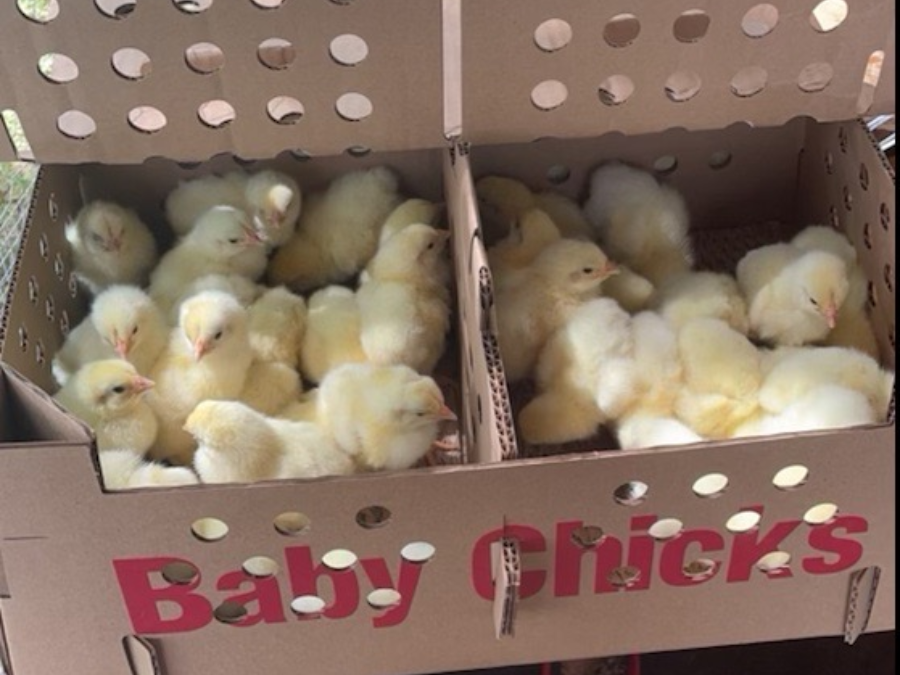Brooding is the liftoff phase of chick development. What happens in the brooder will determine how well your chickens will perform throughout their life. Broiler chicks are in the brooder for 14 – 21 days depending on location and climate. The first 14 days of life are the building blocks of chick development. During these first 14 days, a chick’s skeletal, muscular, neurological, and digestive systems are developing quickly so extra care needs to be taken during this time. This article focusses mainly on broilers, but the principles are the same for pullets and turkeys. The results of a successful brooding phase are optimizing weight gain, decreasing disease, and decreasing mortality. This is what this article will focus on, including the fundamentals of raising chicks, or any livestock, really.
When preparing the brooder, we need a plan. The brooder should be set up 24 hours before chicks arrive. If you’re raising multiple batches of chicks throughout the year, clean and sanitize between groups and set up with fresh bedding. Day old chicks have very little immune response making them more susceptible to disease. Think about the immune system of a newborn versus the immune system of an 8-year-old, an 8-year-old has been exposed a variety of germs and is more resistant to getting sick compared to the newborn. Feeders and waterers should be cleaned and sanitized between groups to reduce the potential spread of disease. Preparing the brooder includes turning on the heat source to get the brooder to temperature. I’ll talk more on temperature in the next paragraph.
Temperature
Controlling temperature is crucial for chick health and development because chicks can’t maintain their internal body temperature. Chicks that get cold have higher mortality, impaired immune and digestive function. The cute, fluffy, yellow feathering on chicks is not insulating, so their environment needs to be warm enough to help them maintain body temperature. One way to gauge how warm a chick is by feeling their feet. Chicks lose a lot of internal body heat from their feet, meaning if their feet are cold, so are the chicks. Your brooder needs a reliable heat source like an infrared heat lamp or propane heater to help control temperature. Now, the question is which heat source is better? Propane heater tends to do a better job at maintaining temperatures, especially in larger buildings or in colder temperatures. Before your chicks arrive, give the brooder 24 hours to heat up. This will allow the bedding and feed to warm up. Brooder temperature needs to be 90⁰F for the first week, and after day 8, start decreasing brooder temperature slowly. Monitor brooder temperature using a thermometer or digital infrared thermometer. Humidity also plays a major role in temperature. As humidity increases the temperature in the brooder should decrease, below is a chart from Ross 308 management guide that shows this. I can’t stress enough the importance of brooder temperature.
|
Temperature Recommendation Based on House Relative Humidity
|
|||||
| 30% | 40% | 50% | 60% | 70% | |
| Age (Days) | °F | °F | °F | °F | °F |
| 0 | 93.2 | 91.4 | 89.6 | 87.8 | 86 |
| 7 | 89.6 | 87.8 | 86 | 84.2 | 84.4 |
| 14 | 84.2 | 82.4 | 80.6 | 78.8 | 77 |
Air Quality
Air Quality is essential for health and growth. Air needs exchanged frequently for good oxygen levels and to reduce ammonia, carbon dioxide, and dust. When ammonia levels reach 10 ppm, Chickens start suffering from lung damage. The human nose detects ammonia levels at 25 ppm. By the time we start smelling ammonia levels, the chickens are suffering from lung damage. Now the frequency of air exchange depends on a few factors:
- Number of birds
- Age and weight of birds
- Operating Fan Capacity
The Ross Management Guide (click here) has a calculation for minimum ventilation fan timer settings on page 138-139. This calculation will help you figure out how long and how often your fan needs to run. While improving air movement will help with ammonia levels, maintaining clean, dry bedding will reduce ammonia levels as well. Poor air quality can trigger diseases like pneumonia and ascites, damage the respiratory tract, and reduce bird performance.
Bedding
There are a variety of bedding options available. Pine shavings, rice hulls, and dried sphagnum peat moss are a few of the more common. Pine shavings are economical and have decent absorbency. The average price for pine shavings is $1.32 per cubic foot (ft3). Rice hulls is another good litter option with the average price of $2.90/ft3. Lastly there’s peat moss with the highest absorbency, which should help prevent diseases. The average price for dried sphagnum peat moss is $7.99/ft3. The only downfall to peat moss is that it’s very dusty. However, the dustiness does not affect chick’s respiratory system. While the dustiness is annoying and you’ll have to clean out the waterers more often, chick health will make peat moss worth the dust. Good bedding management will help improve chick health, help with air quality, and prevent disease.
Water
Water is an essential nutrient for all living creatures, and water consumption drives feed consumption. Before placing chicks in the brooder, dip their beaks in water to help them find water and encourage them to drink. Water temperature should be around 80⁰F. Cold water will reduce chick’s internal body temperature, chilling them. Adding ½ oz (1 tbsp) of apple cider vinegar per gallon of water to the water in the brooder will give your chicks an extra boost. Apple cider vinegar is a natural electrolyte source. Think of it as a natural Gatorade. To help chicks drink plenty of water, it’s important to keep waterers clean. Try to scrub waterers daily to prevent any biofilm from growing. If you run you’re finger along the bottom of the drinker (this does not apply to nipple drinkers) and it’s slimy, that’s a biofilm. This will cause birds to drink less water. Remember, water consumption drives feed consumption.
Feed
Feed is critical for success. You can have the best set up with the best manager, but your birds will not perform well if you do not have a quality feed. Feed should be fresh, balanced, and accessible. Ideally, feed is fed within 30 days of being made. Vitamins tend to be less stable and will deplete over time. After 6 months, the vitamin levels will be lower than what’s guaranteed on the tag. Mainly because of vitamin levels, avoid feeding feed older than 3 months. Feed should also be formulated for the stage of development. Depending on the breed of broiler, you will need a 21-23% protein chick starter feed. Lastly, feed needs to be easily accessible and in a size that chicks can consume. A crumble or fine mash are good particle sizes for young chicks. If feed size is too large for chicks, they cannot and will not eat the feed they need to grow and thrive.
We also want to encourage chicks to find feed quickly when placed in the brooder. Chicks are born with an instinctive pecking behavior. When they peck at the ground at a day or so old, they don’t know what they’re pecking at. Lay brown paper or cardboard on top of bedding and mound feed on the paper in addition to having plenty of feeder space will reduce eating shavings and will encourage them to find feed faster. Crops should be filled and refilled within the first 48 hours. Having more than 1-2% runts suggests chicks didn’t find feed soon enough. Give the chicks 2 hours after placing them in the brooder. After 2 hours come back in and check crop fill. Gently feel the crop using your thumb and pointer finger. If the crop is full, soft, and rounded, it means the chick has found feed and water. At 2 hours, you want 75% of chick’s crops filled. At 48 hours, you want 100% of chick’s crops filled.
Observation
Lastly, observation is key to raising any livestock! Chicks in the brooder should be checked multiple times a day. Spending time with chicks and watching chick comfort will help you catch small problems before they become big problems. Catching problems early on and acting on them will help keep chicks healthy and productive. You can gauge a lot by chick placement. If chicks are huddled together, the temperature is too cold. If chicks are spread around the perimeter and are far away from the heat, temperature is too hot. We want chicks evenly spread throughout the brooder. Seeing some chicks eating, some drinking, some sleeping suggests birds are comfortable and happy.
To summarize, the first 14 days are critical for chick growth and development. Brooder temperature and air quality are important for helping chicks stay warm and encouraging feed and water consumption. Feed needs to be fresh and balanced, and water needs to be clean and fresh. Finally, observation is key to raising all livestock!
Extra effort in the brooding phase will be rewarded in final flock performance!

